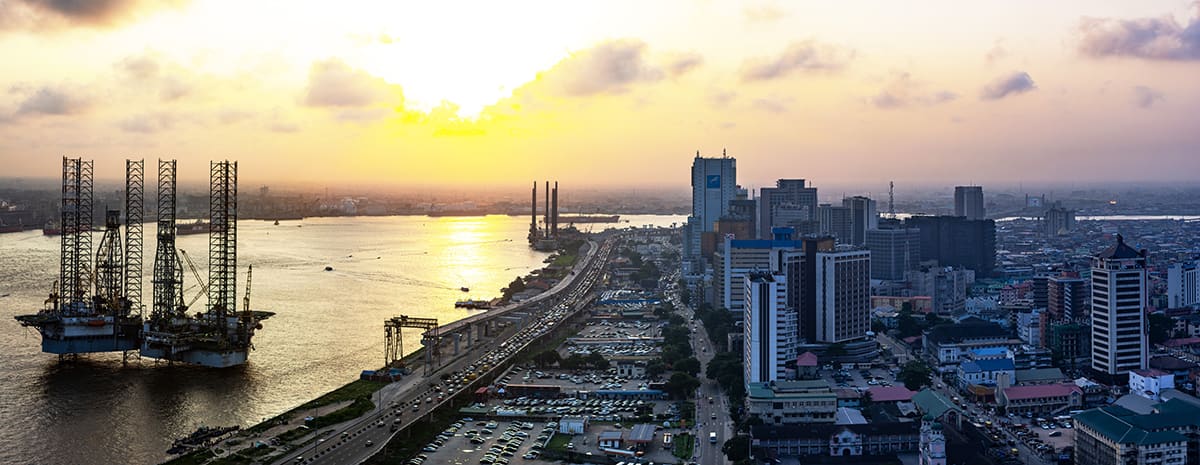Nigeria needs major upgrades but its risk profile scares investors. A blended approach could leverage public funds to spur private support.

An infrastructure-investment deficit has become, perhaps, the most significant constraint to sustainable economic growth in Nigeria and long-term private capital remains in short supply. Power generation and distribution, roads, highways, rail lines, oil refineries, gas pipelines and other critical structures need urgent intervention.
No one knows precisely how much money Nigeria needs to remediate its infrastructure. Moody’s Investors Service estimates that it would take approximately $3 trillion over the next 30 years, or a capital expenditure (capex) of $100 billion annually. Such a figure is more than 15 times the national government’s 2020 budget for capex.
The constraints that poor infrastructure put on the economy have been an ongoing concern for years. A decade ago the African Development Bank (AfDB) put the country’s capex needs at $35 billion annually. A 2013 AfDB paper claimed that “if the infrastructure endowment of Nigeria were raised to that of the Africa region’s middle-income countries, it could boost annual GDP growth by about four percentage points.”
Over the years, however, “population growth and perennial shortfalls in annual infrastructure spending continue to balloon the size of the infrastructure deficit,” says Chinua Azubike, CEO of Lagos-based Infrastructure Credit Guarantee Company (InfraCredit), a specialized infrastructure credit guarantee institution backed by the Nigerian Sovereign Investment Authority, KfW Development Bank, Africa Finance Corporation, the African Development Bank, and Private Infrastructure Development Group companies GuarantCo and InfraCo Africa.
Take, for example, the Apapa Port Complex in Lagos, where congestion has reportedly more than doubled the cost of moving goods containers from the port into the city, and more than tripled the cost of moving the same containers to other parts of Nigeria. Containers have to travel long distances by road because other ports in the country have ceased to operate. There are similar stories in other sectors: inadequate facilities make power transmission and distribution inefficient and expensive, for example, and pipelines cannot be relied upon to transport the products.
“Infrastructure deficit in Nigeria is huge,” says Bashirat Odunewu, group executive of energy and infrastructure at First Bank of Nigeria (FBN), one of the country’s first-tier lenders.
Power supplies have not been improved since the government privatized most of the sector. The transmission and distribution networks cannot support expanded generation, so little progress has been made in adding to the supply. In 2019, the International Monetary Fund put the ratio of Nigeria’s infrastructure stock to GDP at about 25%, which was significantly below the 70% norm.
Shoddy, outdated or missing equipment even diminish the productive capacities of critical-service teachers and medical personnel. “Nigeria’s biggest asset is undoubtedly its huge human resources,” he adds. “Hence, quality education that enhances productivity can help improve output and income levels.”
The deficit presents opportunities for investors, from direct investment under build-operate-transfer arrangements to portfolio investments in government and agency bonds that fund infrastructure projects. Yet total investment—from public and private sources—has failed to keep pace with needs. As a percentage of GDP, gross capital formation in Nigeria ranged between 14.9% and 16.4% between 2010 and 2017, according to the World Bank. Nigeria’s neighbor Ghana performed better, its ratio ranging from 12.8% to 30% during the same period.
The AfDB report also noted that infrastructure investment in particular remained low, mostly from public sources. The amount and type of funding and the long tenor—more than 10 years at a low interest rate—puts such investments beyond commercial banks’ usual remits, according to FBN’s Odunewu.The banks can only provide long-term loans for project development, usually up to about seven years, she adds.
The major constraint to infrastructure financing is the risk, agrees InfraCredit’s Azubike. “Private capital providers, including banks, pension funds, conventional asset managers, and long-term and general insurance carriers, mostly have low-to-moderate risk appetites—even as they continue to demonstrate their preference for financing infrastructure assets with development impact.”
Infrastructure project risks include the execution capacity of the sponsors, the political environment and a variety of external factors such as exchange rates. Odunewu cites examples of unexpected cost overruns due to currency depreciation, poor project management and sudden changes in government policies that affect cash flow and repayments.“Unfortunately, there are more failed infrastructure projects than successful ones in the country,” she says.
Pivot to China
In the last six years, Nigeria turned to China for infrastructure financing more than ever. And China, in the midst of its Belt and Road Initiative, was glad to oblige. As of the end of December 2020, Nigeria borrowed $3.7 billion from the Export-Import Bank of China, according to Nigeria’s Debt Management Office (DMO). The loans have a concessional interest rate of 2.5% with a 20-year tenor and a seven-year moratorium.
The loans are tied to 15 infrastructure projects, including the Idu-Kaduna section of the Nigerian Railway Modernization Project; Abuja Light Rail Project; and Nigerian Four Airport Terminals Expansion Project, which comprises Abuja, Kano, Lagos and Port Harcourt, according to the DMO. Among the others are Nigeria Greater Abuja Water Supply Project, Nigerian-Communications-Satellite and several additional railway projects.
Blended-Finance Benefits
That Nigeria’s infrastructure deficit nevertheless continues to grow indicates a need to adopt financing models that are commercially friendly and attractive to private investors, says Abiola Rasaq, head of corporate strategy at Nigeria’s Central Securities Clearing System.
One probable solution to financing the considerable infrastructure deficit is the use of blended finance, according to Rasaq. “Blended finance is the strategic use of development finance tools in mobilizing required finance, especially private capital, for infrastructure projects that enhance sustainable development,” he says. “It is a structure that helps open up a tap for the flow of capital that would otherwise not have flowed toward infrastructure projects.”
An essential element of the blended-finance model is derisking the infrastructure project to a level that meets the risk/reward tolerance of commercial investors. InfraCredit provides a platform for such blended-finance opportunities in Nigeria by providing local currency guarantees and mobilizing long-term debt financing for infrastructure assets in the country, says Azubike. Such guarantees act as a catalyst to attract domestic credit from pension funds, insurance firms and other long-term investors into creditworthy infrastructure projects, thereby deepening the Nigerian debt capital markets.
“Resolving private investors’ concerns on the inherent and perceived risks of infrastructure assets–and providing comfort to these important stakeholders in a way that sustainably mobilizes private capital toward infrastructure assets–is at the core of InfraCredit’s operation,” Azubike says.



